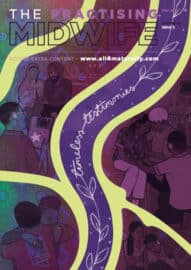Decolonising Midwifery Education Part 1: How Colour Aware Are You When Assessing Women With Darker Skin Tones in Midwifery Practice?
All authors from Leicester School of Nursing and Midwifery, De Montfort University:
Maureen Raynor – Senior Lecturer, Midwifery
Zaheera Essat – Lecturer, Midwifery
Diane Ménage – Senior Lecturer, Midwifery
Maxine Chapman – RM, Senior Lecturer, Midwifery, and Fair Outcomes Champion: Decolonising DMU Project
Bernadette Gregory – RM, Senior Lecturer, Midwifery, and Fair Outcomes Champion: Decolonising DMU Project
Published in The Practising Midwife Volume 24 Issue 6 June 2021 https://doi.org/10.55975/GVHN3309
Summary
In midwifery practice, skin assessment is an important element of any physical examination of women. Fundamentally, key practice recommendations are centred on visual and tactile cues to assist with the identification of changes in skin appearance. Although visual signals are more readily discernible in women with light skin tones, they may be more challenging to detect in women with darker skin tones. As a means of decolonising midwifery theory and practice, this article highlights ways in which midwives can develop confidence in skin assessment when caring for women with dark skin tones.*
*NB we have sourced images via stock websites and from the generous public, to whom we are grateful for supporting this important work of decolonising the curriculum.
Introduction

There is a dearth of literature regarding the nuanced presentation of clinical features in mothers and babies with darker skin tones. Yet skin examination is a vital component of any physical assessment of maternal and neonatal wellbeing, not least because it plays a crucial part in determining physiological parameters alongside blood pressure, temperature, respirations and pulse, and aids in the timely recognition of developing complications that may lead to poor outcomes.
A recent MBRRACE report1 on maternal morbidity and mortality in the UK highlighted the stark health disparities between women from Black, Asian and Minority Ethnicities (BAME) compared with those who identify as white. The COVID-19 pandemic has also magnified the problem. Therefore the specific risk to women with darkly pigmented skin should no longer be overlooked. It might be possible that lack of understanding on how deviations from the norm may manifest in individuals with Brown and dark skin could mean that early developing morbidity is missed.2 Against this background, the drive towards decolonisation in midwifery theory and practice is helpful in building momentum in terms of midwives being colour aware instead of colour blind. This will close the gaps, reduce health inequalities and rebalance the Eurocentric perspective of the language used to communicate assessment and documentation of skin changes in women with darker skin tones. Furthermore, the lack of resources showing a balance between how critical illness may manifest in dark skinned women compared with their white-skinned counterpart is of concern, as it reinforces colour blindness and whiteness as the norm.
The skin is the largest organ in the body; as alluded to earlier, it can be readily observed in an unobtrusive way
to provide a gauge of perfusion, body temperature and oxygen saturation levels. A full and thorough skin assessment should include a detailed history taking, listening to women and effective communication, both verbal
and written. Commonly, midwives are educated to recognise certain changes in skin colour that signal deviations from normality. Much of this knowledge is based on the care of women with light skin tones. It is much more challenging to determine these visual cues in women with darker skin. It is imperative therefore that midwives are educated to assess and recognise skin changes in all skin tones in order that they can care for women with confidence using clinical judgement. This article is the first in the series of two that places the spotlight on the subtleties involved when assessing the skin of women with darker skin tones. The second article will explore the neonatal context.
Colour awareness is an important consideration when conducting examination of maternal skin in midwifery practice. This is a necessary step in order to reduce health disparities and be thorough and inclusive in our approach of all women, regardless of their ethnicity and skin colour
Colour awareness vs colour blindness
In acknowledging the diversity in skin tones, it is important to remind midwives that skin pigmentation relies on four main factors: the variety of carotene pigments in the subcutaneous layer of the skin; the amount of haemoglobin and general oxygenation; the degree of melanin present in the epidermis; and the presence of other essential pigments such as bile.3 Melanin is the dark natural pigment that gives skin, hair and eyes their colour.3 The amount of melanin present in a person’s skin is primarily determined by their genetic inheritance. The levels of melanin are also influenced by lifestyle and behaviours that result in frequent exposure to the sun. More melanin is produced with repeated sun exposure.4 Therefore, melanin plays an important role in protecting the skin from the harmful effects of UV radiation, filtering sunlight before it damages the cells of the skin. Hence the close association between an individual’s skin tone and their (or their parents) place of origin.4 Clearly, individuals with dark skin tones have more melanin than those with lighter skin tones. Melanin is synthesised by a specialised group of cells known as melanocytes and sunlight promotes the synthesis of melanin, leading to darkening of previously synthesised melanin.4 The variations and differences in skin pigmentation across the racial spectrum are due to the amount of melanin produced rather than the number of melanocytes per se.4
Decolonisation in midwifery theory and practice is helpful in building momentum in terms of midwives being colour aware instead of colour blind
Classification of skin types

There are a number of nomenclature used in determining skin type when assessing individuals. The popularised Fitzpatrick5 system (see Table 1) of classification lists six gradations. However, it is argued that this spectrum is quite limited and biased towards Caucasians as only one category is used to depict the myriad of individuals with variations of darker skin tones, therefore see Picture 1 for greater variation.
Antepartum period: Skin conditions of significance
The pregnant woman will experience a number of changes and this includes vicissitudes to the skin. Some changes to the skin may be aesthetic in complication and resolve after birth but, as in the case of melasma, the dermatoses are more prominent in skin of darker tones and the characteristic dark patches to the woman’s face can create significant distress and may not fade immediately after birth. Treatment measures are complex and often contraindicated in pregnancy and with breastfeeding.6 Polymorphic eruption of pregnancy is a rash that can present across the body and create significant discomfort; namely pruritus, burning and stinging. The presentation of the lesions in lighter skin tones is pink or red6 but in darker skin tones will be the tone of the skin or darker, which may not be immediately noticeable and thus requires a review of symptoms experienced by the woman (see Picture 2). Atopic eruption of pregnancy is suggested to be benign,6 however, it causes chronic eczema with dry, thickened and itchy areas.

In darker skin tones, it can cause complications like dark spots or hyperpigmentation in the presence of acne or other skin irritations. Early treatment, particularly with acne, is therefore suggested but many pharmacological preparations are contraindicated in pregnancy.7 Pemphigoid gestationis is a rare autoimmune disorder that can occur in pregnancy and after birth.8 It presents as inflammatory skin lesions and severe pruritus. Although it is more common in fairer skin tones, the presentation in darker skin tones will be a darker-toned rash that develops into blisters rather than a pink rash.
Bruising
Bruises, irrespective of skin tone, will develop in the same way in antepartum women. The expected redness to the
skin, however, will not initially present in darker skin tones (see Pictures 3-5). This is significant as trauma, including cases of domestic abuse, have the potential of being missed. In darker skin tones the affected area, as the bruise develops, will become darker in colour.9 The anticipated bluish or purple colour will be seen on lighter skin tones. The palpation of the skin where obvious bruising is not seen may identify a swelling, which will warrant further investigation.



Pallor and cyanosis
Skin colour is often used as a predictor for morbidity in antepartum women. Although this may be a useful indicator of compromise, the presentation will differ depending on the skin tone of the woman. Cyanosis is often indicated by a woman’s skin colour and in lighter skin tones the bluish tint of the skin and mucous membranes is evident.2 In darker skin tones, however, it will be recognised as a greyish or white colour, which will be seen to the skin in the region of the mouth and conjunctivae. Pallor, too, which may indicate anaemia, in darker skin tones is assessed by examining any paleness to the conjunctivae2 and mucosa rather than the limbs.
The midwife’s confidence, therefore, in the holistic assessment of women postnatally, including women of varied skin tones, is essential to ensure anomalies and potential complications are recognised and referred appropriately
Admission to hospital and/or stay in hospital
During labour in a hospital setting, each NHS hospital has clinical guidelines and risk assessment proforma such as the Braden scale (reported to be the most validated and reliable risk assessment tool) to identify women at risk in order to prevent pressure ulcer formation.10 Regardless of skin colour, an initial risk assessment of the skin must be carried out within two hours of the admission process for all women who present with known risk factors, such as altered level of consciousness/sensory impairment and impaired mobility. For the majority of women who do not have any identifiable risk factors, the risk assessment must be performed within six hours of admission.10 For women who are immobile and/or at greater risk, for example, those with major disability, especially where mobility is affected, there must be re-evaluation of the skin at intervals. This is particularly important if there is any change in the woman’s condition, such as epidural in situ or delay in the second stage of labour; following obstetrical interventions such as an instrumental birth or episiotomy; handover of care/change of shift; if the woman is transferred to a postnatal ward and on discharge from the hospital setting10 (how to assess for ulcers is provided in the postnatal section). While we were unable to source an appropriate image for this article, there are numerous pictures of pressure ulcers in darker skin tones that can be accessed via Google.
Intrapartum period
Many midwives use their skills of observations to identify visual cues during labour when assessing progress in women who present in spontaneous physiological labour.11,12 These visual cues are commonly referred to as the purple line and rhombus of Michaelis, recognised as less intrusive means of assessment compared to digital
vaginal examinations. The purple line is described as a reddish/purplish or even brown line that arises from the anal cleft/margin, which extends between the buttocks as labour advances.11,12 It is easier to identify on women who are light-skinned but is less useful in women with dark skin tones.11,12,13 However, the rhombus of Michaelis might be a more helpful sign in women with dark skin tone.13 This is where a kite-shaped area between the sacrum and ilea can be observed, regardless of skin colour. It is noticeable towards the commencement of the second stage of labour when the fetal head is deep within the pelvis and the wings of the ilea push outwards to increase the pelvic diameter.11,12 Creating an environment that is conducive to a spontaneous physiological birth often means dim lighting will be a challenge when observing the skin of women with darker skin tones. A torch in this instance can be invaluable, as well as actively listening to women and noting any changes to symptomatology they report. The parameters outlined previously to assess the skin during the antepartum period will also apply in labour.
Postpartum assessment
As midwives, it is urgent that we address the continued racial inequities that exist in healthcare including the fact that women categorised as BAME are more likely to die during the six week postnatal period than white women.1 The midwife’s confidence, therefore, in the holistic assessment of women postnatally, including women of varied skin tones, is essential to ensure anomalies and potential complications are recognised and referred appropriately. Below we offer information of how to carry out a postnatal assessment that is inclusive to women with Black/Brown skin colours.
Breasts
An inspection of the breasts is important where nipple trauma, for instance, may present. Skin lesions to the nipple is considered to be pink or red in colour and during inspection the trauma is clearly visualised but in darker skin tones these typical colour representations will not be evident and will require a consideration of features other than colour.14 These include listening to the woman and asking her about the signs and symptoms she is experiencing. Women who experience breastfeeding complications such as mastitis are often asked to observe for indications like redness to the breast, but in darker skin tones this will not be evident. However, changes to the skin colour, like hyperpigmentation, may be seen. In addition, bruising, is a potential complication of breastfeeding and may also be present. Although the process of bruising, irrespective of skin pigmentation, is mainly consistent, the presentation will vary. In darker skin tones, the trauma may not initially be detected because the reddening of the skin will not be seen, but the skin will appear darker in shade and a swelling might be evident and palpable at the site. Unfortunately, there is a dearth of images related to breastfeeding complications and we hope to update this article at a later date.
Perineal assessment
The skin is assessed to ensure wound healing15,16 during the examination of the perineum; the abdominal wound for signs of infection; and wound breakdown as part of the postnatal examination. Injury to the genitalia of darker skin tones, however, is often not visualised and more likely to be missed and not treated. It is questionable therefore, how effectively perineal trauma, after birth, is recorded for women of darker skin tones. Furthermore, the UK and Ireland Confidential Enquiry into Maternal Deaths identifies that mortality related to genital tract sepsis was largely contributed to delayed diagnosis and incomplete assessment.1 It is suggested that the rate of wound healing varies and scars will eventually fade.16 Yet, in skin of a darker pigmentation, we know that keloid scarring (over granulation/an overgrowth of scar tissue extending beyond the original wound) is more common, which can lead to pain and discomfort. The additional aesthetic complication of wound healing where dyspigmentation results can also have a negative psychological impact.17
Abdominal wound assessment


The skin is also assessed following a caesarean section to ensure effective wound healing. Although in lighter skin tones some redness to the scar may be seen and the scar is expected to fade, in darker skin tones a white or brown discolouration to the scar tissue is likely (see Picture 6). Keloid (see Picture 7) and hypertrophic (raised at the wound only) scarring, following caesarean section, are also more likely in darker skin tones and excessive scarring can impact on the mother’s physical and psychological health.18
Pressure ulceration


Pressure ulceration, which is not given enough consideration, is an avoidable injury to the mother.19 For women who are immobile for any length of time, it is imperative to assess for ulceration.10 Early changes in the skin are noted through the use of inspection and tangible signs like non-blanching erythema response, but this will not be visualised with darker skin tones.20,21 Furthermore, the dependence on redness as an indicator of inflammation is not suitable for all skin tones. Other cues that establish tissue perfusion need to be considered. These include:
- applying light pressure and assessing for any pain or discomfort
- when observing for pallor, the mucous membrane must be examined in darker skin tones as abnormal lightening of the skin will not be seen as would be the case in lighter skin tones
- changes in skin colour other than redness:
- like darker tones that is suggestive of hypoxia
- increased warmth in comparison to surrounding skin
the skin may appear oedematous, indurated, taut and shiny.19
For women who are immobile for any length of time, it is imperative to assess for ulceration
An assessment by touch, therefore, will be as invaluable as visualisation – see Picture 8 and 9 for advanced pressure sores – to be avoided.
Legs
The maternal legs are examined to identify complications like thromboembolism, in particular deep vein thrombosis. Not all typical signs like redness to the affected area22 will be seen in darker skin tones and will require a review of maternal concerns and an assessment of signs and symptoms of deep vein thrombosis that include:
- Skin changes: oedema, warmth and discolouration (although typically red, the affected area should be compared to a non-affected area to identify any changes in skin tone).
- Unilateral calf pain or tenderness.



Recommended further reading
Knight M, Bunch K, Tuffnell D, Shakespeare J, Kotnis R, Kenyon S, Kurinczuk JJ (eds.) on behalf of MBRRACE-UK. Saving Lives, Improving Mothers’ Care – Lessons learned to inform maternity care from the UK and Ireland Confidential Enquiries into Maternal Deaths and Morbidity 2016-18. Oxford: National Perinatal Epidemiology Unit, University of Oxford; 2020.
This recent report continues to shine the light on disparities in health outcomes for women from minority ethnic groups, highlighting further inequalities brought about by the coronavirus pandemic and placing emphasis on actions needed to address systemic biases.
The expected redness to the skin, however, will not initially present in darker skin tones. This is significant as trauma, including cases of domestic abuse, have the potential of being missed
Conclusion
Maternal skin colour, including the assessment of varied skin tones, plays a substantial role in the assessment of wellbeing. Colour awareness, therefore, is an important consideration when conducting examination of maternal skin in midwifery practice. This is a necessary step in order to reduce health disparities and be thorough and inclusive in our approach of all women, regardless of their ethnicity and skin colour. This is a good example of how midwives can help close the gap and prevent inequalities in care. Additionally, real change in midwifery theory and practice requires vision and courage to confront uncomfortable truths and identify areas where care can be improved. To achieve this, midwives require safe spaces where they can come together and allow enlightening conversations to flow. Finally, to aid personal reflection, readers are asked to review the accompanying case vignette as well as the recommendations for practice and the related questions pertinent to the assessment of skin colour. TPM
References
1. Knight M, Bunch K, Tuffnell D et al, eds. Saving lives, improving mothers’ care: Lessons learned to inform maternity care from the UK and Ireland confidential enquiries into maternal deaths and morbidity 2015-17. https://www.npeu.ox.ac.uk/downloads/files/mbrrace-uk/
reports/MBRRACE-UK%20Maternal%20Report%202019%20-%20WEB%20VERSION.pdf. Published 2019. Accessed November 24, 2020.
2. Mukwende M, Turner M, Tamony P. Mind the Gap – A handbook of clinical signs in black and brown skin. London: St George’s University of London; 2020.
3. Maranduca M, Branisteanu D, Serban et al. Synthesis and physiological implications of melanic pigments (Review). Oncology Letters. 2019;17(5):4183-4187.
4. Del Bino S, Duval C, Bernerd F. Clinical and biological characterization of skin pigmentation diversity and its consequences on UV impact. International Journal of Molecular Science. 2018;19(2668):1-44.
5. Sachdeva S. Fitzpatrick skin typing: applications in dermatology. Indian J Dermatol Venereol Leprol. 2009;75(1):93-6.
6. Maharajan A, Aye C, Ratnavel R, Burova E. Skin eruptions specific to pregnancy: an overview. The Obstetrician and Gynaecologist. 2013;15(4):233-240.
7. Awan S, Lu J. Management of severe acne during pregnancy: A case report and review of the literature. International Journal of Women’s Dermatology. 2017;3(3):145-150.
8. Sävervall C, Sand F, Thomsen S. Pemphigoid gestationis: current perspectives. Clinical, Cosmetic and Investigational Dermatology. 2017;10:441-449.
9. Scafide K, Sheridan D, Campbell J, DeLeon, Hayat M. Evaluating change in bruise colorimetry and the effect of subject characteristics over time. Forensic Science, Medicine and Pathology. 2013; 9(3):367-376.
10. National Institute for Health and Care Excellence. Pressure ulcers: prevention and management, Clinical Guideline (CG179) London: NICE; 2014.
11. Shepherd A, Cheyne H, Kennedy S, McIntosh C, Styles M, Niven C. The purple line as a measure of labour progress: a longitudinal study. BMC Pregnancy and Childbirth. 2010;10(54);1-7.
12. Kordi M, Irani M, Tara F, Esmaily H. The Diagnostic Accuracy of Purple Line in Prediction of Labor Progress in Omolbanin Hospital, Iran. Iran Red Crescent Med J. 2014;16(11):e16183.
13. Wickham S. Evidence for the purple line. https://www.sarawickham.com/questions-and-answers/evidence-for-the-purple-line/. Published 2014. Accessed January 3, 2021.
14. Cervellini M, Gamba M, Coca K, Vilhena Abrao A. Injuries resulted from breastfeeding: a new approach to a known problem. Revista da Escola de Enfermagem da U S P. 2014;48(2):346-356.
15. Everett J, Budescu M, Sommers M. Making sense of skin colour in clinical care. Clinical Nursing Research. 2012;21(4):495-516.
16. Royal College of Obstetricians and Gynaecologists. Perineal wound breakdown. https://www.rcog.org.uk/en/patients/tears/perinealwound-dehiscence/. Published 2020. Accessed September 22, 2020.
17. Chadwick S, Heath R, Shah M. Abnormal pigmentation with cutaneous scars: A complication of wound healing. The Indian Journal of Plastic Surgery. 2012;45(2):403-411.
18. Diehl C. Article Commentary: OB-GYN Surgeries: Why We Should Recommend to Our Patients a Preventive Management for Keloids and Hypertrophic Scars. Clinical Medicine Insights: Women’s Health. 2012;5:31-38.
19. Deery R. Wound care and pressure ulceration in midwifery: a neglected area? Wounds UK. 2011;7(1):10-12.
20. Clark M. Skin assessment in dark pigmented skin: a challenge in pressure ulcer prevention. Nursing Times. 2010;106(30):16-17.
21. European Pressure Ulcer Advisory Panel. Pressure ulcer treatment guidelines. EPUAP: Oxford; 1999.
22. National Institute for Health and Clinical Excellence. Venous thromboembolic diseases: diagnosis, management and thrombophilia testing. London: NICE; 2020.







